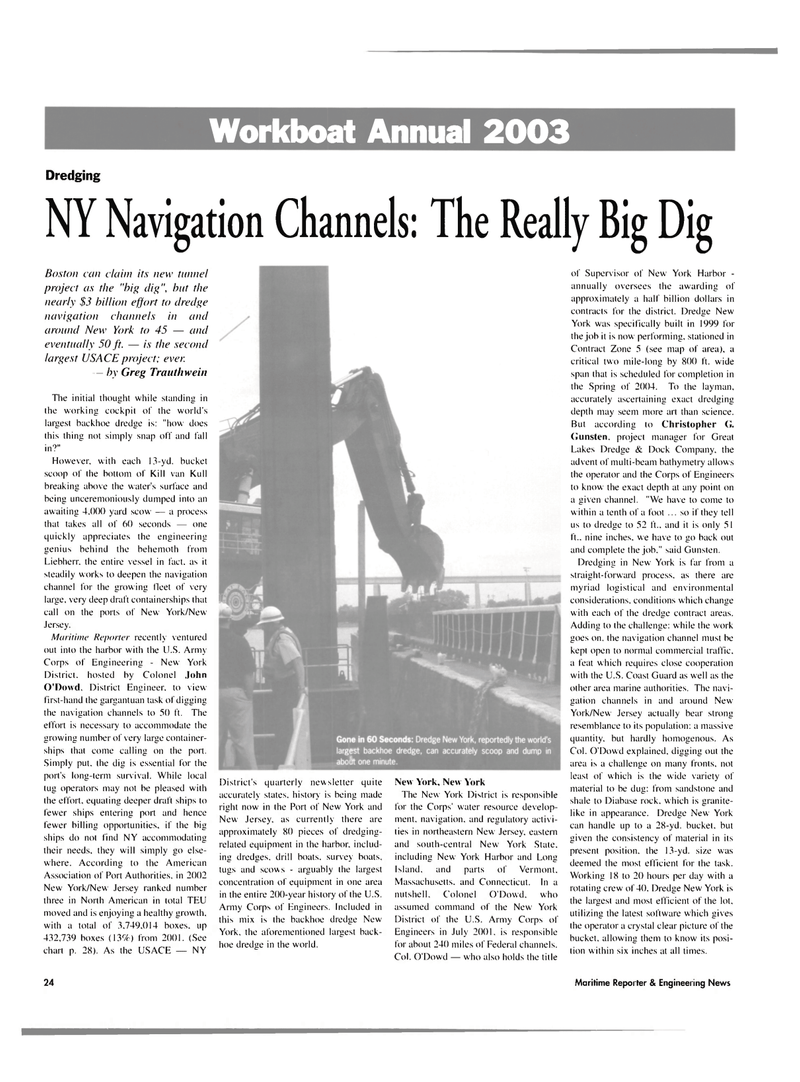
Page 24: of Maritime Reporter Magazine (November 2003)
Read this page in Pdf, Flash or Html5 edition of November 2003 Maritime Reporter Magazine
Workboat Annual 2003
Dredging
NY Navigation Channels: The Really Big Dig
Boston can claim its new tunnel project as the "big dig", but the nearly $3 billion effort to dredge navigation channels in and around New York to 45 — and eventually 50 ft. — is the second largest USACE project; ever. - by Greg Trauthwein
The initial thought while standing in the working cockpit of the world's largest backhoe dredge is: "how does this thing not simply snap off and fall in?"
However, with each 13-yd. bucket scoop of the bottom of Kill van Kull breaking above the water's surface and being unceremoniously dumped into an awaiting 4.000 yard scow — a process that takes all of 60 seconds — one quickly appreciates the engineering genius behind the behemoth from
Liebherr, the entire vessel in fact, as it steadily works to deepen the navigation channel for the growing fleet of very large, very deep draft containerships that call on the ports ot New York/New
Jersey.
Maritime Reporter recently ventured out into the harbor with the U.S. Army
Corps of Engineering - New York
District, hosted by Colonel John
O'Dowd, District Engineer, to view first-hand the gargantuan task of digging the navigation channels to 50 ft. The effort is necessary to accommodate the growing number of very large container- ships that come calling on the port.
Simply put, the dig is essential for the port's long-term survival. While local tug operators may not be pleased with the effort, equating deeper draft ships to fewer ships entering port and hence fewer billing opportunities, if the big ships do not find NY accommodating their needs, they will simply go else- where. According to the American
Association of Port Authorities, in 2002
New York/New Jersey ranked number three in North American in total TEU moved and is enjoying a healthy growth, with a total of 3,749,014 boxes, up 432,739 boxes (13%) from 2001. (See chart p. 28). As the USACE — NY of Supervisor of New York Harbor - annually oversees the awarding of approximately a half billion dollars in contracts for the district. Dredge New
York was specifically built in 1999 for the job it is now performing, stationed in
Contract Zone 5 (see map of area), a critical two mile-long by 800 ft. wide span that is scheduled for completion in the Spring of 2004. To the layman, accurately ascertaining exact dredging depth may seem more art than science.
But according to Christopher G.
Gunsten, project manager for Great
Lakes Dredge & Dock Company, the advent of multi-beam bathymetry allows the operator and the Corps of Engineers to know the exact depth at any point on a given channel. "We have to come to within a tenth of a foot ... so if they tell us to dredge to 52 ft., and it is only 51 ft., nine inches, we have to go back out and complete the job." said Gunsten.
Dredging in New York is far from a straight-forward process, as there are myriad logistical and environmental considerations, conditions which change with each of the dredge contract areas.
Adding to the challenge: while the work goes on. the navigation channel must be kept open to normal commercial traffic, a feat which requires close cooperation with the U.S. Coast Guard as well as the other area marine authorities. The navi- gation channels in and around New
York/New Jersey actually bear strong resemblance to its population: a massive quantity, but hardly homogenous. As
Col. O'Dowd explained, digging out the area is a challenge on many fronts, not least of which is the wide variety of material to be dug: from sandstone and shale to Diabase rock, which is granite- like in appearance. Dredge New York can handle up to a 28-yd. bucket, but given the consistency of material in its present position, the 13-yd. size was deemed the most efficient for the task.
Working 18 to 20 hours per day with a rotating crew of 40, Dredge New York is the largest and most efficient of the lot. utilizing the latest software which gives the operator a crystal clear picture of the bucket, allowing them to know its posi- tion within six inches at all times.
District's quarterly newsletter quite accurately states, history is being made right now in the Port of New York and
New Jersey, as currently there are approximately 80 pieces of dredging- related equipment in the harbor, includ- ing dredges, drill boats, survey boats, tugs and scows - arguably the largest concentration of equipment in one area in the entire 200-year history of the U.S.
Army Corps of Engineers. Included in this mix is the backhoe dredge New
York, the aforementioned largest back- hoe dredge in the world.
New York, New York
The New York District is responsible for the Corps' water resource develop- ment. navigation, and regulatory activi- ties in northeastern New Jersey, eastern and south-central New York State, including New York Harbor and Long
Island, and parts of Vermont,
Massachusetts, and Connecticut. In a nutshell. Colonel O'Dowd. who assumed command of the New York
District of the U.S. Army Corps of
Engineers in July 2001. is responsible for about 240 miles of Federal channels.
Col. O'Dowd — who also holds the title 24 Maritime Reporter & Engineering News

 23
23

 25
25
